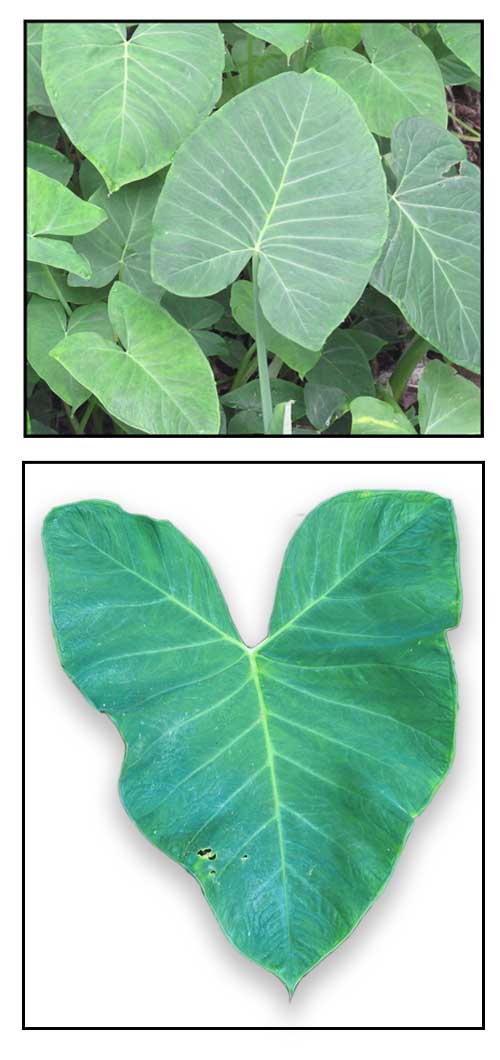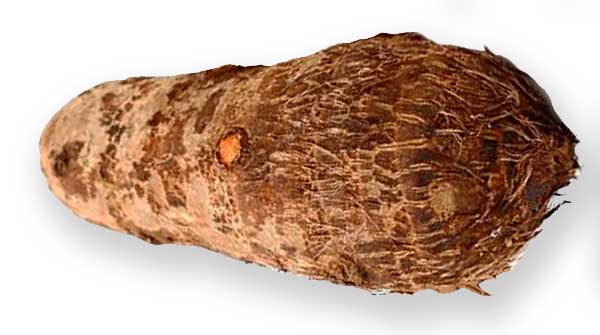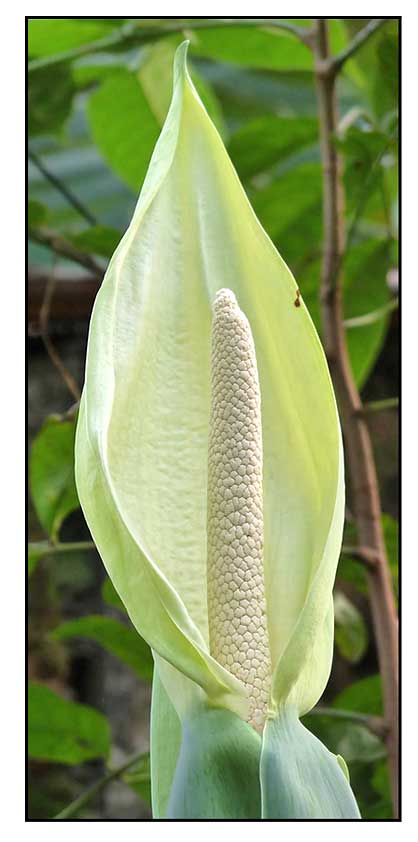 Gen info Gen info
- Xanthosoma is a genus of flowering plants in the arum family, Araceae. It is native to tropical America but widely cultivated and naturalized in other tropical regions. Some are grown for their starchy corms, as important food staple of tropical regions, such as: malanga, otoy, otoe, cocoyam (new cocoyam), tannia, tannier, yautia, macabo, ocum, macal, taioba, dasheen, quequisuqe, 'ape and Singapore taro. Some are grown as ornamental plants. (4)
- Etymology: The genus name Xanthosoma derives from Greek words xanthos, meaning 'yellow', and soma, meaning 'body, referring to the stigma or yellow inner tissue. (4)
- Xanthosoma sagittifolium, or tannia, produces an edible, starchy corm.
It is often confused the related plant Colocasia esculenta (taro), similar in appearance and use. Both are collectively called Cocoyam. (5)
- Tannia is among the world's most important tuber crops and feeds 400 million worldwide. There are several varieties, the two most common being the red flesh and white flesh varieties.
Cultivars with purple stems or leaves are called blue taro, purplestem taro, purple stem tannia, and purple elephant's ear. (5)
Botany
• Growth form: A fast-growing herb that reaches up to 2 m tall. Foliage: Its main stem is short, thick, globose to cylindrical, produce arrow-shaped leaves. The petiole grows to 1.5 m long, attached at the base of the leaf. Its leaves are dark green or purplish in color, grows up to 90 cm long and 60 cm wide. Flowers: Flowers are produced in a spadix inflorescence. The boat-shaped spathe can come in colors of light green, silver green, yellow green or purple. The spathe hoods over the spadix, measuring 15 – 20 cm long. Tubers: Tubers are pale brown with white, pink or yellow flesh. Each plant produces up to 10 or more tubers. (Flora & Fauna Web)
Distribution
- Cultivated and naturalized in the Philippines. (2)
- In
Luzon: Batangas, Mountain Province, NCR; Mindanao: Bukidnon.
- Native to Brazil North, Brazil Northeast, Colombia, Costa Rica, Ecuador, Panamá, Peru, Venezuela. (1)
 Constituents Constituents
- Tubers contain approximately 85% carbohydrates in dry matter and about 10% protein. It is also rich in vitamin A and C, and a good source of potassium and calcium.
- Proximate analysis (% dry matter, DM) of flower of X. sagittifolium Eket: yellow flesh cultivar) revealed: moisture (wet weight) 91.86), ash 17.26, crude fiber (3.11), crude protein (9.30), crude lipid (9.98), carbohydrate (60.62), and calorific value of 368.43 Kcal/100g). (see study below) (7)
- Nutritional profile of cocoyam per 100 g (3.5oz): Energy: 594 kJ (142 kcal); Carbohydrates 24.6 g, Sugars 0.49, Dietary fiber 5.1g; Fat 0.11 g; Protein 0.52g; Vitamins:
Thiamine (B1) 0.107mg/9%, Riboflavin (B2) 0.028 mg/2%, Niacin (B3) 0.51 mg/3%, pantothenic acid (B5) 0.336mg/7%, Vitamin B6 0.331mg/25%, Folate (B9) 19 µg/5%, Vitamin C 5mg/6%, Vitamin E 2.93mg/20%; Minerals: Calcium 18mg/2%, Iron 0.72mg/6%, Magnesium 30 mg/8%), Manganese 0.449 mg/21%, Phosphorus 76mg/11%, potassium 484 mg/10%, Zinc 0.27mg/3% (Source: USDA National Nutrient Database, 2014) (10)
- Preliminary phytochemical screening of Xs stem extracts showed presence of cardiac glycosides, steroids, flavonoids, tannins, phenols, and terpenoids. Chloroform extract showed majority of the phytoconstituents. Methanol extract showed maximum percentage of phenolic and flavonoid content than aqueous and chloroform extracts. Total phenol content in methanol, chloroform, and aqueous stem extracts was 47.35, 16.35, and 11.8172 mg of GAE/g DW. Total flavonoid content was 119.94, 6.35, and 25.60 QE/g DW. Results showed the methanolic extract with good amount of phenolic and flavonoid contents. (11)
Properties
- Caution / Hazards: All plant parts contain calcium oxalate crystals, which is toxic fresh, and if eaten causes the sensation of hundreds of small needles digging into the mouth, tongue, and throat. The crystals are easily broken down by drying or thorough cooking, which makes it safe for eating. (19)
- Studies have suggested nutrient, antioxidant, antibacterial, antitumor, antileukemic, anti-anemic, analgesic, anti-inflammatory, cholesterol lowering, bile acid-binding, probiotic properties.
Parts used
Corm, leaves..
 Uses Uses
Edibility
- Both corm and leaves are suitable for human consumption after cooking. Small sercondary corms are primarily for culinary use, similar to potatoes: boiled, fried, roasted, steamed, baked, or ground into flour. The leaves as used as green leafy vegetables, similar to spinach. 5)
- In Suriname, pom, shredded roots is baked with chicken, fruit juices, salted meat, and spices. Leaves are also baked with Maggi-cube (chicken boullion cube) and eaten with rice and chicken or salted beef. (5)
Folkloric
- In the Philippines, the inflorescence sap is used for wound healing.
- In traditional Brazilian medicine used to treat bone disease, such as osteoporosis.
- Tannia has been used as medicine against tarantula, scorpion, and snake bites. (5)
- In Cameroon, used for the treatment of jaundice. Also used by traditional healers as purgative or vomitive, to which some drops of kerosene or local salt to enhance the purgative or vomitive effect. (14)
- In Bangladesh,
decoction of corm peel used for treatment of diarrhea.
Others
- Flour: Made by slicing the rhizome, drying it, and finely ground. Starch yield is about 15%. However, because of high moisture content of corms and cormels, tannia has low storability. The white flesh variety is used for making bread. The flour can also be used in meat and milk products. (5)
-
Fodder: Primary corms are usually used as animal feed rather than human consumption because of higher amounts of oxalates. Studies have shown it is possible to replace up to 45% of expensive maize grain in chicken feed with tannia corn meal. (5)
-
Preservative and additive: Tannia can be used to make food preservatives (lactic acid), energy bars, chips and crisps, additives in beverages, sauce thickeners, purees, and sauces. (5)
-
Biofuel: There is possibility for use of tannia to make ethanol for biofuel because of high starch content and yield. (5)
-
Agroforestry: Used as nurse-crop for cacao.
Studies
• Calcium Content for use in Osteoporosis: To support its traditional use for prevention of bone diseases, study evaluated the free calcium concentration of leaves Fresh and cooked leaves of X. sagittifolium yielded 273.17 and369.81 mg/100 g, respectively. Results support use of the plant as health supplement in poor communities, suggesting studies that validate safe use. (7)
• Flower as Nutritional Supplement and Medicine: Study evaluated the potential applications of the flower of Xanthosoma sagittifolium *yellow flesh cultivar) as food supplement and medicament for for promotion of human health. Results revealed samples(Eket and Ussien Udim) examined yielded all the amino acids naturally present in proteins. Phytochemicals included cardiac glycosides, deoxy-sugars, alkaloids, terpenes, saponins, and flavonoids. The Eket sample was nutritionally superior to the Essien Udim sample. High levels of nutrients and phytochemicals revealed medicinal/health advantage of the flower of X. sagittifolium over other culinary leafy vegetable. Results suggest potential for flower of Xs as food supplement and medicament for health. (see constituents above) (7)
• Antioxidant / Antibacterial / Leaves: Study evaluated phytochemical contents, antioxidant and antibacterial potentials of X. sagittifolium ethanolic leaf extract. Phytochemical screening revealed carbohydrates, tannins, flavonoids, steroids, and alkaloids. The leaf extract showed free radical scavenging activity by DPPH assay. Antimicrobial sensitivity by disk diffusion method showed mild activity against four tested bacteria viz., Bacillus subtilis, Staphylococcus aureus, Escherichia coli, Salmonella enterica, Vibrio cholera, and Shigella dysenteriae. (8)
• Antileukemic / Leaves: Study evaluated a hydroethanolic extract of X. sagittifolium leaves (HEXs-L) for antitumor and chelation activities. Results showed the HEXs-L exhibited cytotoxic effects against the immortalized line of human-T-lymphocyte (Jurkat) and myelogenous (K562) leukemia cells, but not nontumor RAW 2264.7 macrophages or NIH/3T3 fibroblasts. Study revealed HEXs-L exhibited chelating activity, invitro antitumor activity, arresting cell cycle and inducing apoptosis of leukemia cells, providing evidence for potential of taioba leaves in cancer therapy. (9)
• Anti-Anaemic / Petiole: Study evaluated plant petiole methanolic extracts for anti-anaemic activity, given orally to phenylhydrazine-induced anemic albino rats in doses of 200 mg/kg and 400 mg/kg for 14 days, measuring Hb, Hct, Hct, indices, and WBC count. Results showed noteworthy, dose-dependent increases in hemoglobin, RBC count, and red cell indices. The anti-anemic and hematinic activity was attributed likely to high iron content and phytochemicals, and suggests potential as safe alternative to synthetic iron preparations, especially in resource poor environments. (12)
• Antioxidant / Corm: Study evaluated the total phenolic, flavonoid contents and in vitro antioxidant activity of methanol extract of Xs corm. Results showed the corm exhibited 0.32 g/100g total phenolic, 0.26g/100g flavonoid, and scavenging activity of 78.22% DPPH, 69.11% hydroxy radical, 83.27% superoxide radical and 76.11% ABTS radical cations. (13)
• Analgesic/ Anti-Inflammatory / Rhizome: Study evaluated the analgesic and anti-inflammatory potential of methanol extract of X. sagittifolium in mice, using tail immersion and acetic acid induced writhing method and carrageenan-induced paw edema method, respectively. Results showed considerable analgesic and anti-inflammatory activity, justifying use of Xs in folk medicine to treat pain. (15)
• Comparative Effects on Gut Microbiome Malanga and Potato Tubers: Malanga is used as medicinal food for infant development and gastritis. Study compared the physiochemical properties and gut microbial effects of malanga versus potato (Solanum tuberosum). Malanga showed higher starch (70.7% vs 66.3%), lower amylose: amylopectin (0.33 vs 0.59), higher free sugar (5.44% vs 3.23%), lower viscosity (271 vs 863 mPa.s), and higher bioaccessible and bioavailable sugar (0.89 vs 0.11 g bioaccessible sucrose per 20g load in vitro; blood glucose levels of 129 vs 95.2 and 133.8 vs 104.3 mg/dL after 20 and 60 min invivo). Gut microbiota of mice fed a high fat diet with 20% malanga for 14 days showed significantly higher α diversity than those on 20% potato, indicating minor physiochemical differences between similar tuber crops are associated with significantly different effects on gut microbiome. (16)
• Cholesterol Reducing / Bile-Acid Binding / Taioba Leaves: Study evaluated the effect of lyophilised taioba leaf (LTL) as a hypolipidemic and prebiotic agent in Wistar rats in groups fed a high-fat supplemented with cellulose, inulin, and LTL that provided 10% (w/w) taioba fiber for 4 weeks. Results showed the addition of LTL to the diet resulted in reduced weight gain, reduced liver fat, and increased fecal mass and lipid, in addition to higher fecal short chain fatty acid and bile salt concentrations. Only the taioba group exhibited lower serum cholesterol concentration and higher body ash content. Both high bile salt binding capacity and high fermentability of LTL suggest potential for a protective effect against cardio-vascular diseases and bowel cancer. (17)
• Drying of Leaves / Effect on Bioactive Compounds: Taioba has superior nutritional characteristics compared to most conventional vegetables. However, preservation is difficult because of high moisture content. Study evaluated the drying kinetics of leaves and the effect of temperature on bioactive compounds. Leaves were dehydrated at 25, 30, 35, and 40 °C using a heat-pump dryer and 50, 60, 70 and 80°C in a conventional convective dehydrator. Effective diffusivity coefficient increased with drying air temperature with activation energy of 45.40 kj mo for conventional dryer and 110.26 kj mol for heat-pump dryer. Among bioactive compounds, vitamin C content was higher in taioba dehydrated using the heat-pump dryer. (18)
Availability
- Wild-crafted.
- Cultivated.
- Plants in the cybermarkets. |

![]()






